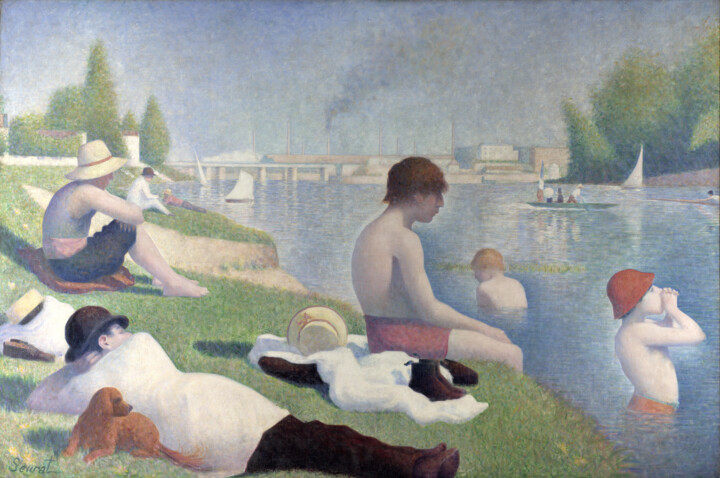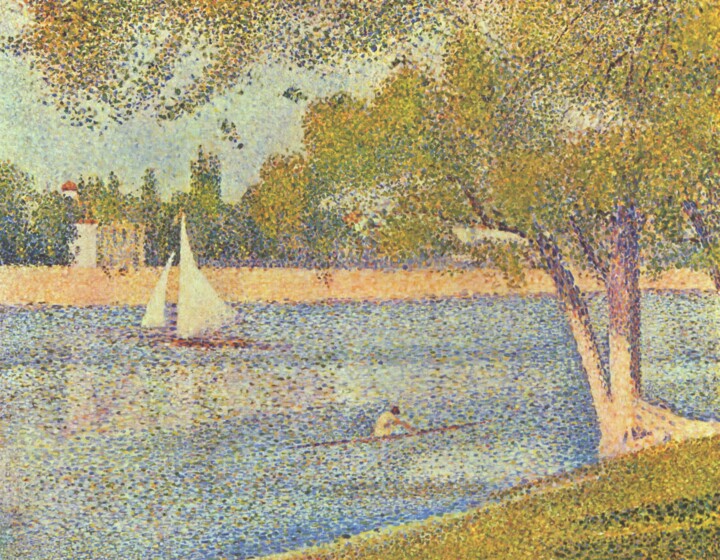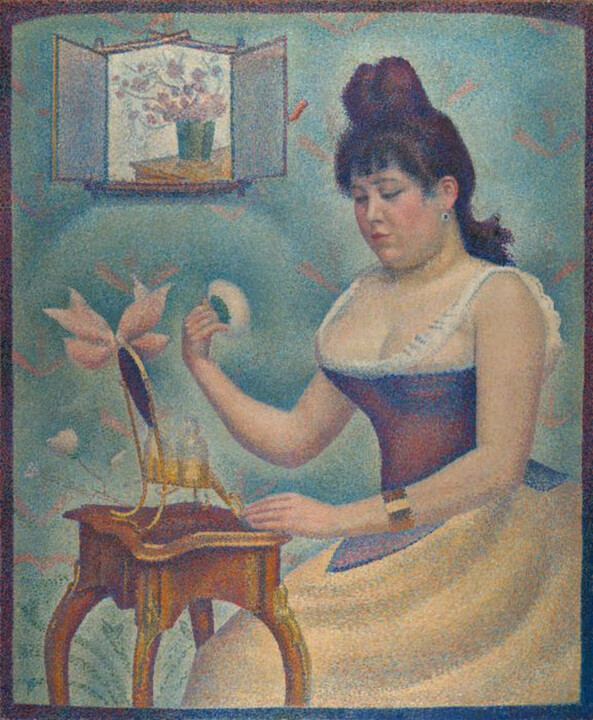 Georges Seurat - A Sunday Afternoon on the Island of La Grande Jatte, 1884–86. Oil on canvas, 207.5 × 308.1 cm. Art Institute of Chicago
Georges Seurat - A Sunday Afternoon on the Island of La Grande Jatte, 1884–86. Oil on canvas, 207.5 × 308.1 cm. Art Institute of Chicago
Who was Georges Seurat?
Georges Pierre Seurat was a French painter who lived from 1859 to 1891. He was born in Paris and is best known as the pioneer of the painting technique known as pointillism. Seurat's innovative approach to art had a significant impact on the development of modern art.
Seurat studied at the École des Beaux-Arts in Paris and initially worked in a more traditional style. However, he soon began experimenting with a technique that involved applying small, distinct dots of color to the canvas, which he called "divisionism" or "chromoluminarism." This technique later became known as pointillism.
"A Sunday Afternoon on the Island of La Grande Jatte" is perhaps Seurat's most famous work and exemplifies his mastery of pointillism. The painting, created over two years (1884-1886), demonstrates his meticulous attention to detail and his exploration of color theory.
 Georges Seurat, Study for "A Sunday Afternoon on La Grande Jatte", 1884, oil on canvas, 70.5 x 104.1 cm, Metropolitan Museum of Art, New York
Georges Seurat, Study for "A Sunday Afternoon on La Grande Jatte", 1884, oil on canvas, 70.5 x 104.1 cm, Metropolitan Museum of Art, New York
Seurat's artistic approach went beyond simply creating visually striking images. He was interested in the scientific and mathematical aspects of art, studying theories of color perception and optical effects. His work was influenced by the ideas of the Neo-Impressionist movement, which sought to bring a more scientific approach to painting.
Unfortunately, Seurat's career was cut short when he died at the age of 31 due to illness. Despite his short life, his artistic contributions were significant, and his technique and ideas continue to be studied and admired today.
From 1883 until his death Georges Seurat exhibited his artwork at the Salon, the Salon des Indépendants (The Société des Artistes Indépendants), Les XX in Brussels, the eighth Impressionist exhibition, as well as other exhibitions held in France and abroad.
 Georges Seurat, 1888
Georges Seurat, 1888
Société des Artistes Indépendants
The Société des Artistes Indépendants (Society of Independent Artists) or Salon des Indépendants was an influential organization founded in Paris, France, in 1884. It was established with the aim of providing a platform for artists to exhibit their work outside the confines of the official Salon, which was a highly conservative and restrictive art institution at the time.
The Société des Artistes Indépendants was committed to promoting artistic freedom, embracing diversity, and rejecting traditional hierarchies and judgments. They aimed to create an egalitarian environment where all artists, regardless of their style, reputation, or background, could exhibit their works. The organization's motto was "sans jury ni récompense" (without jury or reward), emphasizing their commitment to inclusivity and equal opportunities for all artists.
The society held annual exhibitions known as the Salon des Indépendants, which became an important platform for emerging artists and avant-garde movements. These exhibitions showcased a wide range of artistic styles and techniques, including Impressionism, Post-Impressionism, Fauvism, Cubism, and other groundbreaking movements of the time.
It has contributed significantly to the democratization of art, challenging the traditional art establishment and providing a platform for artists to showcase their work on their own terms. The organization's commitment to artistic independence and inclusivity has left a lasting impact on the art world, influencing subsequent alternative art spaces and organizations worldwide.
Prominent artists such as Georges Seurat, Paul Cézanne, Paul Gauguin, Henri Matisse, and many others participated in the exhibitions of the Société des Artistes Indépendants. These exhibitions often generated public interest and played a crucial role in the development and recognition of the new artistic movement Neo-Impressionism.
Neo-Impressionism and Pointillism
Neo-Impressionism and Pointillism are two closely related artistic movements that emerged in the late 19th century, primarily in France. While Neo-Impressionism is the broader movement, Pointillism is a specific technique associated with it.
Neo-Impressionism was developed as a reaction against the spontaneous brushwork and subjective color of Impressionism. Neo-Impressionist artists sought to bring more scientific and systematic principles to painting, incorporating theories of color perception and optical effects.
Pointillism, as developed by Georges Seurat and Paul Signac, was a technique within Neo-Impressionism. It involved the application of small, distinct dots or points of pure color to the canvas. These dots were intended to optically blend together in the viewer's eye, creating a greater luminosity and vibrancy in the painting.
Here are some notable examples of artworks that exemplify Pointillism: "A Sunday on La Grande Jatte" (1884-1886) by Georges Seurat, "The Circus" (1891) by Georges Seurat, "Femmes au Puits" (1892) by Paul Signac, "L'Hirondelle Steamer on the Seine" (1901) by Paul Signac, "Portrait of Irma Sèthe" (1894) by Théo van Rysselberghe, "Bridge in London" (1889) by Jan Toorop, "Regatta in Venice" (1903-04) by Henri-Edmond Cross. These artists contributed to the development and diversification of Pointillism, each bringing their unique style and interpretation to the technique.
 Théo van Rysselberghe - Portrait of Irma Sèthe, 1894. Oil on canvas. 197 × 114.5 cm. Musée du Petit Palais, Geneva, Switzerland
Théo van Rysselberghe - Portrait of Irma Sèthe, 1894. Oil on canvas. 197 × 114.5 cm. Musée du Petit Palais, Geneva, Switzerland
The main principles of Neo-Impressionism and Pointillism can be summarized as follows:
Division of Color: Neo-Impressionists believed that color should be divided into its component parts and applied in separate dots or strokes rather than being premixed on the palette or canvas. The use of individual dots allowed for a more precise control of color interactions and optical effects.
Optical Mixing: Instead of physically mixing colors on the palette, Neo-Impressionists relied on the viewer's eye to optically mix the dots of color placed side by side. This optical mixing created a sense of luminosity and vibrancy that differed from the traditional approach of blending colors directly on the canvas.
Scientific Approach: Neo-Impressionists were influenced by scientific theories of color and light, particularly the work of chemist Michel-Eugène Chevreul and physicist Ogden Rood. They studied the principles of complementary colors, simultaneous contrast, and color harmony, applying these theories to their compositions.
Systematic Application: The application of the dots or points of color in Pointillism required meticulous planning and precision. Artists would often create preliminary studies and color charts to determine the optimal placement of colors and achieve the desired visual effects.
Depiction of Light and Atmosphere: Neo-Impressionists aimed to capture the effects of light and atmosphere in their paintings. By using small dots of pure color, they believed they could better convey the luminous quality of light and its interaction with the surrounding environment.
Georges Seurat's "A Sunday Afternoon on the Island of La Grande Jatte" is one of the most iconic examples of the Neo-Impressionist movement and showcases the Pointillist technique. Through the application of countless individual dots, Seurat achieved a remarkable sense of light, color harmony, and depth in the painting.
“A Sunday Afternoon on the Island of La Grande Jatte”
The painting depicts a scene of leisure and recreation on the banks of the Seine River in Paris. It portrays a group of well-dressed individuals, both young and old, enjoying a sunny afternoon in the park. The figures are carefully arranged throughout the composition, appearing almost static and detached from one another.
Seurat meticulously applied small dots or points of pure color to the canvas, which, when viewed from a distance, blend together to create a harmonious and vibrant image. This technique was a departure from the traditional methods of blending colors directly on the canvas.
The use of pointillism allowed Seurat to explore the science of color theory and the optical effects of juxtaposing complementary colors. The painting is characterized by its balanced composition, meticulous details, and the play of light and shadow.
In "A Sunday Afternoon on the Island of La Grande Jatte," Seurat captured a moment frozen in time, presenting a snapshot of Parisian life during the late 19th century. The painting is now housed in the Art Institute of Chicago, where it continues to be admired for its innovative technique and evocative portrayal of a tranquil afternoon.
Interpretation of the painting
Interpreting "A Sunday Afternoon on the Island of La Grande Jatte" involves considering its composition, technique, and context. While individual interpretations may vary, here are some key aspects to consider:
Social Commentary: Seurat's painting can be seen as a social commentary on the leisure activities of the emerging middle class in late 19th-century Paris. The meticulously arranged figures represent a cross-section of society, from the bourgeois couples to the working-class individuals. The strict order and separation among the figures suggest a certain social rigidity and distance between different classes.
Modern Urban Life: The painting captures the transformation of Paris into a modern urban center. The inclusion of the newly developed park on the Île de la Grande Jatte reflects the changing landscape and the integration of green spaces into the city. It portrays the desire for leisure and escape from the bustling urban environment.
Capturing a Moment: Seurat's emphasis on static figures and the absence of narrative suggests a frozen moment in time. The figures seem detached from one another, absorbed in their own thoughts or conversations. The painting invites viewers to contemplate the transitory nature of human interactions and the fleeting nature of time itself.
Scientific Exploration: Seurat's interest in color theory and optics is evident in the technique of pointillism. By using small dots of pure color, he sought to create vibrant and luminous effects. The careful placement of complementary colors creates optical blending and enhances the vibrancy and depth of the painting.
Meditative Quality: The serene ambiance of the scene, the tranquil riverbank, and the gentle sunlight contribute to a meditative quality. The painting invites viewers to immerse themselves in the peacefulness of the moment and contemplate the beauty of nature and human presence within it.
Balance and Harmony: Seurat's meticulous composition and arrangement of figures, along with his use of geometric shapes, contribute to a sense of balance and harmony. The repetition of parasols and umbrellas creates rhythm and visual unity. Despite the individuality of each figure, there is a sense of order and cohesion within the overall composition.
Overall, "A Sunday Afternoon on the Island of La Grande Jatte" offers a multifaceted interpretation, touching on social dynamics, modernization, human connections, and the exploration of color and light. It invites viewers to reflect on the complexities of society and the fleeting nature of human existence while finding beauty in the harmonious interplay of figures and colors.
Historical context
To fully understand the historical context surrounding "A Sunday Afternoon on the Island of La Grande Jatte," it's important to consider the era in which the painting was created, as well as the artistic and social movements of the time.
Industrialization and Urbanization: The late 19th century was a period of rapid industrialization and urban growth in Europe. In France, Paris underwent significant changes with the construction of new boulevards, parks, and public spaces. Seurat's painting reflects this transformation by depicting a scene in the newly developed park on the Île de la Grande Jatte, an island along the Seine River.
Rise of the Bourgeoisie: The painting portrays the emerging middle class, specifically the bourgeois leisure class. As industrialization brought wealth and social mobility, the bourgeoisie sought leisure activities and pursued a desire for leisurely pleasures. Seurat's depiction of well-dressed figures enjoying a Sunday afternoon in the park exemplifies this aspect of the social fabric of the time.
Shifts in Artistic Movements: "A Sunday Afternoon on the Island of La Grande Jatte" was created during a period of artistic exploration and innovation. The painting reflects the influence of the Impressionist movement, which was marked by a departure from traditional academic art and a focus on capturing transient moments and the play of light. Seurat, however, took a unique approach by introducing pointillism and exploring the scientific aspects of color theory.
Reaction to Impressionism: While Seurat's work shares some similarities with Impressionism, it also represents a reaction against its fleeting, spontaneous brushwork. Seurat aimed for a more calculated and systematic approach to painting by employing pointillism, which involved carefully placing individual dots of color to create a sense of harmony and order.
The Neo-Impressionist Movement: Seurat, along with other artists such as Paul Signac, led the Neo-Impressionist movement. They sought to bring a more scientific and methodical approach to painting, incorporating theories of color and optics. Their works emphasized the optical blending of colors rather than the physical mixing of pigments.
By considering these historical factors, we gain insight into the social, artistic, and intellectual climate that shaped Seurat's approach to "A Sunday Afternoon on the Island of La Grande Jatte." The painting reflects both the changing urban landscape of Paris and the artistic movements that were pushing the boundaries of traditional art at the time.


 Selena Mattei
Selena Mattei





